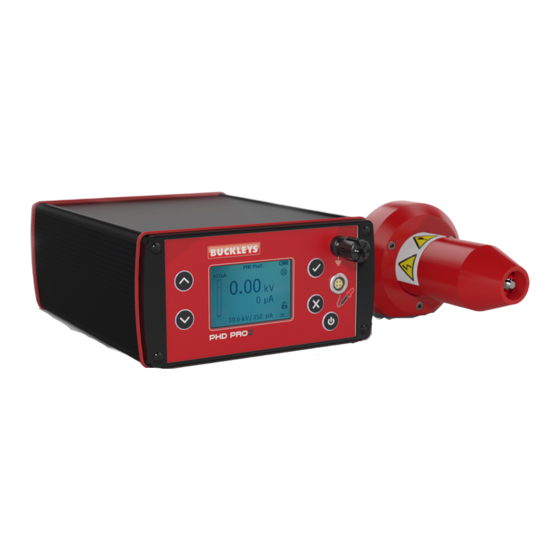Advertisement
Quick Links
Risk Assessment
Make sure you complete a risk assessment before using Buckleys
equipment. The following points offer some guidance:
Personal Safety
• Are users fully trained?
• Are users aware of the risk of electric shock?
• Are the instrument and accessories in good condition, undamaged
and dry?
• Does anyone have a pacemaker, cochlear implant or trans-dermal
implant? If so, can you keep them away?
• Do you have sufficient ventilation?
• Do you have a safe access route to the site? Is fall protection
necessary? If so, is it in place?
• Has the instrument been properly grounded to a metallic grounding
point?
• Should you use the anti-static wristband to prevent static charge
build-up?
Explosion & Fire Risk
• Are you certain that there is no risk of an explosive atmosphere?
• Have all flammable materials been removed from the work area?
EMC & RFI
• Buckleys high-voltage instruments will produce sparks which may
cause radio interference.
• Is there any risk of causing a danger to others – e.g., medical or life
support equipment?
• Is there any risk of causing costs or inconvenience to others – e.g.,
industrial processes, measuring equipment, scientific apparatus,
domestic radio and TV?
Other Risks
• Have you checked that there are no ongoing processes in the area
that may be dangerous – X-ray machines, or other radiation?
• Are you certain that the instrument has not been immersed in liquid,
dropped or otherwise damaged in a way that is not obvious?
• Have you verified that the ground connection is actually grounded?
• Is the person responsible for site safety aware of / fully understanding
the testing you are going to do, and has it been reviewed in line with
the site procedures?
NOTE: Wherever you are intending to use equipment of this type, on
your site or on a customer's, always obtain clearance from the site's
safety officer.
Buckleys (UVRAL) Ltd.
Buckleys House, Unit G, Concept Court, Shearway Business Park, Shearway Road, Folkestone, Kent. CT19 4RG. UK
Tel: +44 (0)1303 278888
Email: sales@buckleys.co.uk
Quick Start Guide
Safety Warnings
IMPORTANT: Do not use with a pacemaker, cochlear implant,
or a trans-dermal electronic implant e.g., glucose monitor.
IMPORTANT: Do not use in combustible atmospheres or ATEX
Hazardous Areas.
Operators of high-voltage test equipment must be suitably
trained, responsible, and authorised.
IMPORTANT: This product can cause radio interference, and
caution must be taken in sensitive environments.
If contact with the test electrode is unavoidable consider wearing
rubber or plastic insulating gloves.
Instrument Settings
1. Power on
2. Display menu
3. Highlight
selection
4. Confirm
selection
5. Adjust setting
6. Confirm setting
7. Return to menu
8. Adjust thickness
The user should establish, in conjunction with their client, and having regard for the material being tested, appropriate test conditions to be applied. In the absence of a
customer specification, Buckleys has found NACE SP0274 to be a useful general-purpose standard, however, it remains the user's responsibility to establish safe and reliable
testing conditions.
Website: www.buckleysinternational.com
Interface
Output
language
Voltage
Scroll to
Scroll to
Set Language
Adjust Voltage
Scroll through the
Adjust the voltage
languages
setting
IMPORTANT: Observe all safety precautions. Do not touch the
live components.
IMPORTANT: Electrical sparks cause ozone (O3) production.
Ensure adequate ventilation.
Safety Warning: Do not immerse equipment in water,
otherwise it must be immediately returned for repair.
IMPORTANT: This instrument must be connected to an
appropriate earth (ground).
The operator should be in good health and - in particular - not suffer
from any cardiac condition.
Sensitivity
Alarm
Threshold
Suppression
Scroll to
Scroll to
Adjust Sensitivity
Alarm Suppression
Adjust the sensitivity
Adjust the suppression
setting
setting
Test
Standard
Scroll to
Test Standard
Scroll through the
standards
Adjust the material
thickness
Advertisement

Summary of Contents for Buckleys PHD PRO2
- Page 1 The user should establish, in conjunction with their client, and having regard for the material being tested, appropriate test conditions to be applied. In the absence of a your site or on a customer’s, always obtain clearance from the site’s customer specification, Buckleys has found NACE SP0274 to be a useful general-purpose standard, however, it remains the user’s responsibility to establish safe and reliable safety officer.
- Page 2 <1m/sec Press and hold the ON button (20°-50°) STOP <1m/sec Buckleys (UVRAL) Ltd. Buckleys House, Unit G, Concept Court, Shearway Business Park, Shearway Road, Folkestone, Kent. CT19 4RG. UK Tel: +44 (0)1303 278888 Email: sales@buckleys.co.uk Website: www.buckleysinternational.com...









Need help?
Do you have a question about the PHD PRO2 and is the answer not in the manual?
Questions and answers